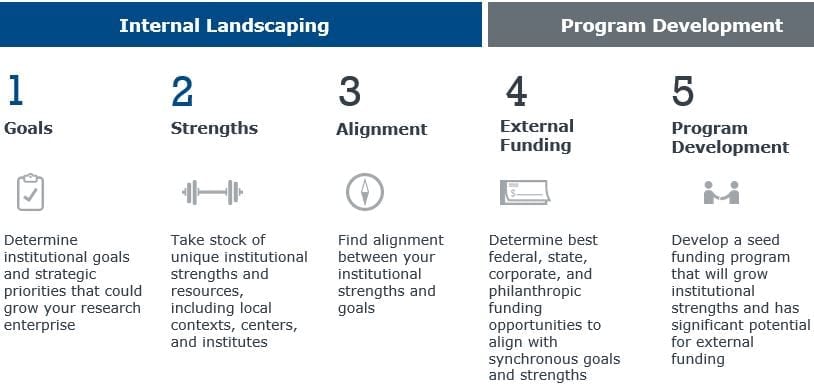Seed funding is crucial for helping faculty start innovative research projects and collect preliminary data necessary to secure extramural funding. This investment approach can pay dividends when targeted to projects and faculty with a strong likelihood of future success.
Seed funds should be carefully distributed to maximize the likelihood that they will lead to large externally funded efforts. When designing (or redesigning) your seed funding programs, there are five easy steps to follow to ensure that your seeds can eventually become a forest.

1. Consider your institutional goals
Your institution’s mission and goals should always be at the forefront of seed funding decisions. If you seek to solve a grand challenge, bridge spliced disciplines, break into a new research area, or support undergraduate research, you should leverage seed funds to incentivize projects that address these goals. If you’re already working towards a particular goal, it may be possible to build on this momentum by investing additional seed funding in existing initiatives.
2. Identify your institution’s unique strengths
Every institution has some unique attributes. Finding yours is crucial to convince external stakeholders to invest in your work.
When doing so, look beyond the obvious strengths you may have such as individual star faculty. For example, think carefully about unique local communities, geographies, and natural resources that give you the opportunity to conduct research. This could be access to freshwater lakes, a non-traditional student body, a population health challenge, a one-of-a-kind scientific facility, or an endangered species habitat. Also consider your institution’s resources and assets, such as key pieces of equipment or existing centers and institutes. By taking an inventory of all of your strengths and resources, you can better set yourself up for strategic seed funding decisions.
3. Look for alignment between your strengths and goals
The next step in building an effective seed funding program is finding the alignment between your goals and strengths. When supporting new on-campus research with the hope of generating additional external support, it is important to communicate why the research has to be done at your institution and nowhere else. Demonstrating the connection to your specific goals, location, and resources is key.
If the alignment isn’t immediately obvious, think creatively about the unique aspects of your institution. Is there a faculty research group quietly doing fantastic work, an undergraduate research program that provides students critical industry skills, or a local community issue that your university could help to solve? The possibilities are endless, you just have to find the one that works for your institution.
4. Scope potential external funding opportunities
This next step is the most important and probably most difficult: Assessing the funding landscape and identifying an appetite for research.
Once you know what you want to do (goals) and what you can do well (strengths), you need to find potential sources of funding, whether from the federal government, private sector, or philanthropic donors. Each has its own requirements and quirks, but all can increase your extramural resources. Reach out to donors, non-profits, and federal program officers when you find proposal calls that might fit your work. You can also convene a panel of successful faculty grant writers to help determine which sources might be best for your specific goals and strengths.
5. Develop your program
The last step is the actual creation of your seed funding program. Now that you know what you want to do, what you can solve, and where to look for funding, you can design your program to steer faculty in that direction.
Create a request for proposals to solicit projects that fit your goals. Ensure that faculty outline how the funds will lead to them applying for specific external grants. It’s also important to include a smaller set of funds for faculty with research specialties that can’t be funded externally.
Lastly, set a cut-off date for the program. Don’t make it indefinite—your goals and strengths change, as should your seed funding programs.
With careful consideration and an eye towards external opportunities, you can create an impactful seed funding program to propel your faculty and on-campus research. The returns on investment go beyond supporting your current faculty, but also include raising the status of your institution as well as attracting talented students and scholars. Go forth and plant a few seeds!
Special thanks to Holly J. Falk-Krzesinski, PhD, Elsevier and Northwestern University for consultation on seed funding